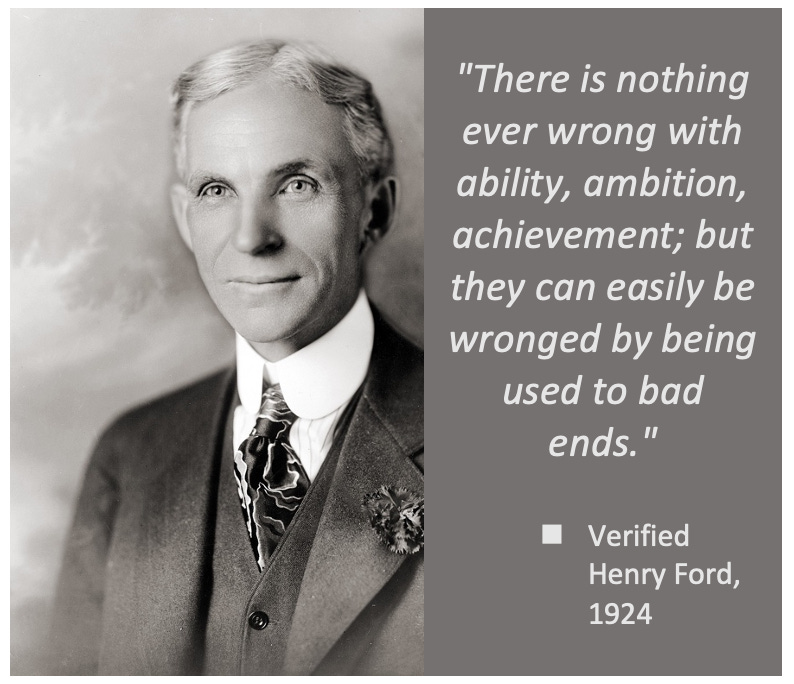Twice the Ford name appears in the “How did we get here?” analysis of a climate crisis.
The first you know. Fordism 1.0
That’s the glorification of Henry Ford, who was the embodiment of the American Century’s capitalist profiteer, which remains a compliment.
While Ford, who was born in 1863 and died in 1947, did not invent the internal combustion engine, he made it affordable. He changed the work day and pay scales not in an epiphany about labor, but to add a third eight-hour shift that kept production humming. With a-car-in-every-driveway optimism, Ford didn’t create a consumeristic middle class, but gave it its earliest expression. His direct contributions to the "progress" economy were in production efficiencies, global expansion and automation, and even then it took a village of unheralded Ford executives to bring his ideas into reality. Ford’s vision created a thirst for fossil fuels and a claim on land for disruptive road systems. He didn’t set out to enflame global geopolitics, but he is cited as inspiration central to the economic priorities of both Nazi Germany and the Soviet Union. He’s credited as a founder of stakeholder-focussed entrepreneurialism for his statements on social justice, but was also a rabid antisemite. Striking among all of his accomplishments, Ford had a knack for stepping into the limelight as America’s first narcissistic, tech billionaire superstar.
Historians have a name for that era of capitalism.
“Fordism”, according to this 2009 researcher, originated as a description of the radical new way of organizing the mass production of automobiles developed by Henry Ford in the early years of the twentieth century. Later, it became used to describe a particular macro-scale model of the organization and linking of mass production and consumption, often seen as the canonical model of capitalist development in the second half of the twentieth century.
Everything since 1913 when Ford’s revolutionary assembly line began churning out a Model T every 90 minutes has been about improving on his business model net of any externalized costs. You’d be hard pressed to find any multinational corporation today that doesn’t link at least some of its business plan back to the myth of Ford.
And yet, in today’s climate blame game, we don’t point fingers at Henry Ford and his legacy as a climate bad guy.
“In all its various guises, it was Fordism — perhaps more than any other system of social organization — that shaped our present, and now deeply uncertain, world order,” writes Justin Vassallo in his 2020 precis of Forging Global Fordism by Stefan Link.
For the most part, climate rage is generically pointed at “government” or “capitalism” or “human moral failings” as bogeymen, rather than a specific choice of technology, a choice of energy to fuel that technology — and later, a choice about how to finance the energy to fuel that technology. This is Fordism’s ongoing link to the climate crisis.
That said, I find only one scholarly work that links Fordism with the current climate crisis. In the 2012 book Capitalism and Climate Change, Lund University Max Koch says:
[Fordism] was characterized… by the parallel restructuring of both the technological and organizational basis of the production process and of the consumption patterns of wage-earners. Yet, the historical development towards compatibility between both entities did not follow any ‘grand plan’, but was the rather accidental occurrence of largely independent socio-economic, political and cultural processes. The environmental crisis and the specific issue of climate change became relevant within the context of the development of this ‘new stage in the regulation of capitalism’.
In other words, Ford had a talent for innovation but even better timing.
Academics like Koch seem united that, by the 1960s, Fordism’s influence had lost its luster in favor of “post-Fordism” shifts in manufacturing: decentralization, global supply chains, specialization, offshored labor, and the earliest sprouting of neoliberal markets and corporate giants. But, it’s only half the story. Much of the so-called post-Fordism economy would be impossible without an evolutionary rebirth of Fordism that remains active today.
It's the second Ford credential in the climate crisis you may not know. Fordism 2.0
That’s the creation of institutional investors, which is a metamorphasis of global finance that must give credit to its Fordism 1.0 roots. Fordism 2.0 does not appear to be part of the Fordism canon, but has had more profound impacts on our climate outcomes than the horseless carriage.
The Ford Foundation was created in 1936 as a tax shelter response to the US Revenue Act of 1935, “which imposed estate taxes of 70 percent on estates of over $50 million,” says InfluenceWatch.
“Because the Ford Motor Company was a family-held business, in which Henry Ford and his son Edsel held, between them, 96.9 percent of Ford stock, it was particularly vulnerable to high estate taxes, which could force the family to sell Ford Motor shares to retain family control.”
By 1947, when Henry Ford died, “the Foundation was endowed with hundreds of millions in Ford stock,” making it the largest private foundation in the world. His grandson, Henry Ford II, who led the foundation toward its international prominence as president and then trustee from 1943 to 1976, called it a “creature of capitalism”.
When McGeorge Bundy, a Kennedy-era Cold War strategist was in charge in 1969, the Ford Foundation was weathering another big tax shift.
By the 1960s, [says the IRS,] there was a growing perception among lawmakers that private foundations, with their small networks of financers and administrators, were less accountable to the public than traditional charities. These concerns were addressed with the Tax Reform Act of 1969, which introduced sweeping reforms to the charitable sector.
In doing so, the IRS “established private foundation rules, including a minimum charitable payout requirement and a four-percent excise tax on net investment income.” That meant that, going forward, an annual investment return must do better than four percent in order to meet the Ford Foundation’s financial obligations. It needed to make more money.
In figuring out how to pivot, the Foundation commissioned an influential legal opinion that solidified the path for everyone toward climate insecurity. This is Fordism 2.0.
The Law and the Lore of Endowment Funds report freed the Ford Foundation's fiduciary-managed endowment (only made possible by Fordism 1.0) from legally-constrained, low-yield investment options. Foundations could then gamble safe money in speculative exchanges that promised, depending on the whims the market, better-than-four-percent financial returns. It provided the playbook for every other fiduciary-led fund, like much larger pension funds, to chase returns and risk. It upended traditional fiduciary principles based on loyalty, care and impartiality and sanctioned financial freedom without a full accounting of consequence and in spite of traditional fiduciary principles.
At a time when America was grappling with an Arab oil embargo and lineups at the pump, Fordism 2.0 stepped in to pay for energy security and protect Fordism 1.0’s dependence on fossil fuel. Climate Safe Pensions says pension funds are presently “among the largest institutional investors in fossil fuels” holding 30% of all fossil fuel shares traded on a stock market. That’s $2 trillion out of a $7 trillion market cap.
This updated take on “prudence” remade the global economy overnight. It singled out billion- and trillion-dollar fiduciary-led pensions and endowments as economic kingmakers. Literally. Since the early 1970s, wherever/however fiduciaries of pensions and endowments decided their billions and trillions should go — persuaded by their non-fiduciary financial experts — set the course for the climate outcomes we are navigating now.
It’s that fiduciary money — invisible to most everyone despite its behemoth financial scale and elegant, human principles — that has unparalleled influence in how and why our economy operates. It’s the vast global money vulnerable to bad guys using it for bad ends dressed up as acceptable or even admirable.
The unverified Henry Ford I quotes include admonitions against finding fault without a remedy at hand. Okay. If we blame Fordism for the climate crisis, then Fordism 3.0 could be the remedy: The fiduciary deployment of climate-scale money used to better ends, such as climate security.
It’s that future-focussed cash-in-hand, says Bank of Nature, that has the mission, duty and scale — and alternative courses of action — to be the tailor-made next-gen good guy on climate.
As a side note, The Henry Ford Museum has a lengthy list of verified Ford I quotes that have aged, actually, pretty well when considered in the climate age… if their intended meanings were authentic. Including:
"There is no failure except failure to serve one's purpose."
"The remains of the old must be decently laid away; the path of the new prepared. That is the difference between Revolution and Progress."
"Many people are busy trying to find better ways of doing things that should not have to be done at all. There is no progress in merely finding a better way to do a useless thing."
"With all the wealth of the world at hand, there are human beings who hunger, whole nations who suffer cold. The judgment for this condition, for misusing Nature's gifts, is the judgment upon man's failure, man's unsteadiness. Leadership is the thing."
What owes its existence, in full or part, to Fordism?
Arguably:
Car culture
Ideological extremism backed by mass production
Suburban sprawl
Robert Moses-style urbanism and ghettoization
Oil exploration, extraction and distribution
Oil crises and petrostate geopolitics
Boom-bust market volatility
Monolithic corporations and their political dark money influence
Non-fiduciary asset managers like BlackRock, Vanguard and Fidelity
Divestment campaigns
Private equity
Extractive neoliberal economics.
Neither Ford nor the Ford Foundation intended, one hopes, end-of-humanity bad things from their actions. They were just making a buck and, for that conspicuous talent, they are remembered with historical fondness.
They pursued money, growth and opportunity: The American Dream of economic progress. They embodied risk-reward optimism and eschewed anti-American caution, especially in post-war expansionism when very real planetary resource limitations were known but not factored. Also, overlooked in Fordism: The geo-biochemical costs to global habitat over time.
Instead, neoliberalism — bankrolled by Fordism 2.0 — has doubled down on the environmental and social problems associated with Fordism. If Ford the entrepreneur 111 years ago and Ford the foundation 55 years ago meant any good guy social impact from their innovations, neoliberal economics has amortized it.
It's their successors who have no excuses.
Ford I was long dead by the time Ford company scientists understood the link between car emissions and climate change in the 1960s but, like other polluters of that time, kept it under wraps. It’s worth noting that today’s Ford Foundation studies many of the social ills created by Fordism’s earlier handiwork.
Of course, the Ford legacy remembers its own story rather differently.
“We are here for one purpose, to help build a better world, where every person is free to move and pursue their dreams,” says Ford Motor Company current brand messaging. “We honor our legacy as we build the future — a better world for generations to come. Because when everyone is free to move, and free to dream, we do what we do best: we change the world.”
Pretty sure that’s not the outcome, as Ford might say himself:
"We live in an era of tremendous facts. And the facts are facts. They are also unpleasant facts, which does not decrease their factual percentage one bit. Our job is to understand them, to recognize their presence, to learn if we can what they signify and not to fall into the error of minimizing facts because they have a bitter flavor."






